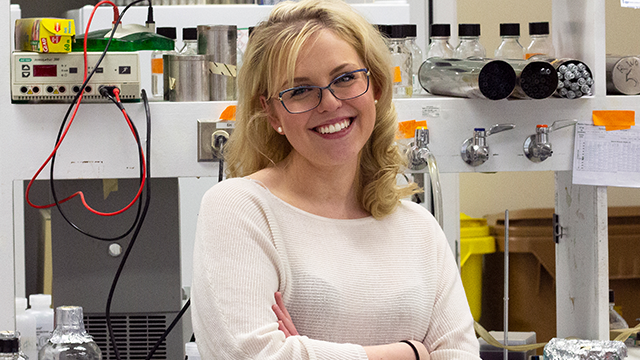
PhD candidate Natasha Saik has a passion for research: "You never know what you're going to get into and there's always an opportunity to learn more, connect the dots, solve the puzzle."
As a student nearing the end of a PhD in cell biology, Natasha Saik, '15 BSc, has plenty of experience trying to explain to novices what she's studying. In fact, she ended up providing her parents with a bit of a script, to help them explain her research to their friends.
"My dad has it in his phone, so whenever someone asks him what I do, he just opens that and reads it to them," she explains with a laugh. "He says, 'This is what she told me but I don't know what it means.'"
This level of complexity may be a deterrent to some, but Saik has always loved the intricacies of cell biology. "It's important to understand the fundamentals of how things work," she says, and she's found her graduate work has encompassed everything that most excited her-biochemistry, molecular biology and cellular structure-during her bachelor's degree in biological sciences, which she also completed here at the University of Alberta.
Saik's research focuses on protein modifications that occur during cell division at the inner nuclear membrane, which surrounds the chromatin, where DNA is housed. Saik has identified one of the modification targets, and it appears the modification is interrupting chromatin's reassociation during mitosis, which ultimately means the new "daughter" cells aren't primed for normal function.
"There are a lot of diseases associated with the failure of chromatin to associate with the inner nuclear membrane," explains Saik, including laminopathies such as muscular dystrophy, lipodystrophies, and premature ageing syndromes.
Chromatin association with the inner nuclear membrane during mitosis is a fairly recent focus of cell biology research, says Saik, in part because the process is so lightning quick it is challenging to study. But that suits her just fine.
"I like learning and I love new things," she says. "I think that's the best part about research-you never know what you're going to get into and there's always an opportunity to learn more, connect the dots, solve the puzzle." The chance to follow her curiosity is what led her into grad studies, and this open-mindedness made it easy for Saik to change directions in her research when, partway into her PhD, a surprise discovery took her into uncharted territory.
Although she had interviewed for graduate programs at other schools, Saik knew from the moment she stepped into the Medical Sciences Building on the U of A's North Campus that she had found her home away from home. "It felt like a place where I could grow and get feedback from lots of professors," she said. She knew the program's excellent reputation and was excited at the prospect of working with well-known researchers such as her now supervisor, Richard Wozniak, and Chris Ptak, the lead on her project. "Chris Ptak basically taught me everything I know," she says. She's grateful for the time he took to teach her when she first arrived in the lab, and to this day he's generous with feedback and advice, she says.
This level of support and mentorship continued even through the research pause necessitated by the COVID-19 pandemic, says Saik, who returned to her bench work on campus May 25 after a couple of months of working remotely. "Every week or so they set up a Skype call to chat, answer my concerns, to see if I was safe, and even share their own research to make me feel included," she says.
As for the forced time away from the lab, "It was nice, in a way, to be able to slow down and focus on a lot of the reading that I tend to push off," she says. She also found the time away gave her a fresh perspective on different paths to pursue in the lab upon her return. And while her love for her work hasn't changed, she has noticed a shift in perspective that she can't help but feel is a healthy one. "With all the current mental-health awareness and the focus on staying well, I've become a bit more cautious not to get run down and overdo things," she says.
"But old habits die hard," she adds with a laugh.
After all, being immersed in the research she loves brings Saik real joy. That's why she knows she will continue to keep her sights firmly trained on the big picture-the ongoing journey of discovery that is basic science. "It's great to go to conferences, publish an article, maybe get a poster prize," she says. "But in my mind, I know my big celebratory moment will be completely understanding how chromatin is regulated at the inner nuclear membrane and what implications this has on all functions of the cell-but I know this might never come, because I'll never know everything."
"And that's part of the fun."